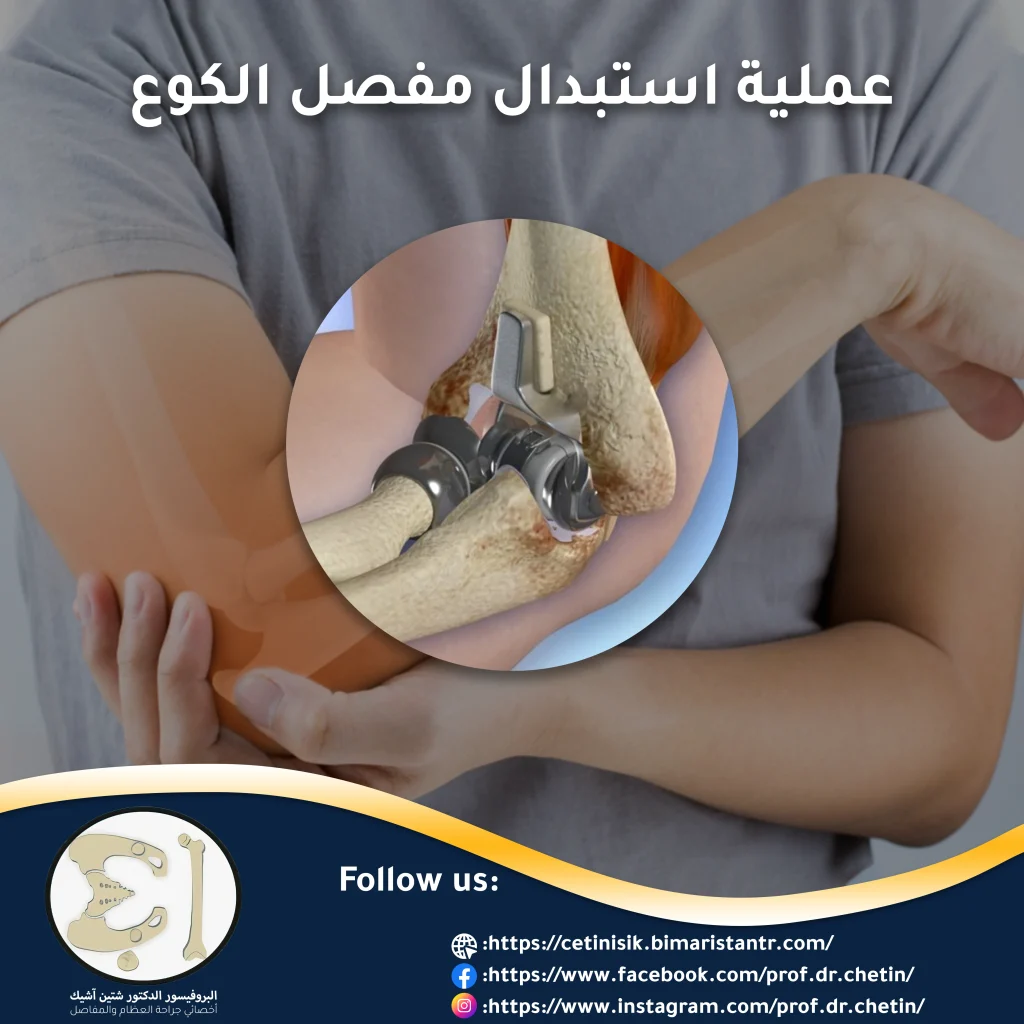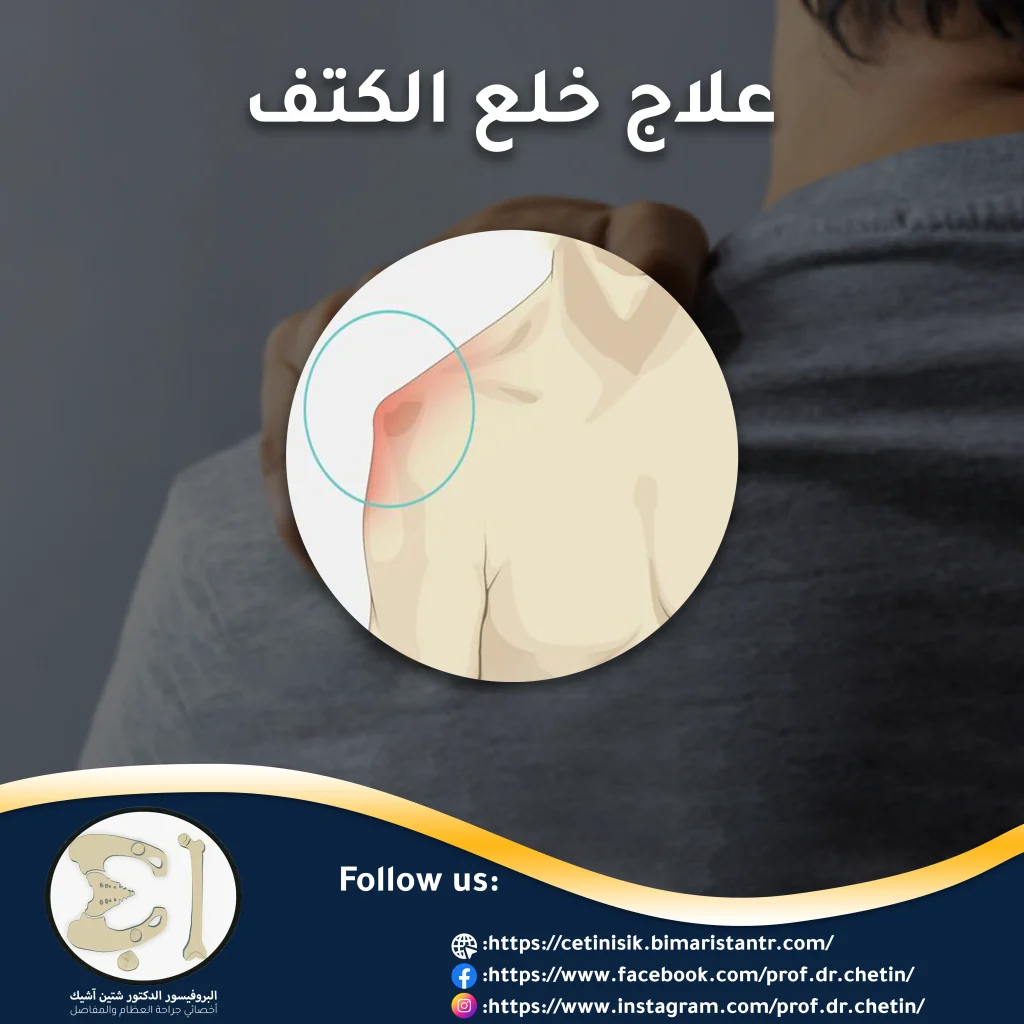Elbow replacement surgery has become a safe solution for many patients who suffer from joint problems in its final stages, as joint replacement surgery remains the last resort.
What is the elbow joint replacement process?
In the process of replacing the elbow joint, sometimes called elbow arthroplasty, the damaged part of the humerus and ulna bones is removed, and the cartilaginous tissue is replaced with artificial elements. Unique materials, such as metal and plastic are usually used to manufacture replacement joints.
Many types of prosthetic joints differ in size and shape, and sometimes partial replacement operations are performed instead of completely replacing the elbow in exceptional cases requiring the presence of Specialist surgeonIt is helpful to discuss this treatment option objectively and seek medical advice if needed.
Over the years, elbow surgeries were limited to many cases of arthritis resistant to conservative treatment. still, the availability of more effective medications reduced the need for this operation. Hence, the demand for it emerged to treat other problems, the most important of which are distal humerus fractures or joint injuries after injuries.

With the change in the reasons for replacing the elbow joint, the need to develop the artificial joint itself has emerged to provide better performance and avoid the need to replace the latter frequently by finding practical metal designs that can maintain their effectiveness for at least 15 years.
An overview of the anatomy of the elbow joint
The elbow is one of the body's synovial joints, as it connects the humerus bone on the one hand and the ulna and radius bones in the forearm on the other. It is a complicated joint with multiple facets and bones separated by cartilage, synovial fluid, and synovial membranes that facilitate movement.
The elbow consists explicitly of three joints between the bones:
- The humeroradial joint
- The humeral joint
- The proximal ulnar-radial joint
The stability of the arm and elbow comes from the distinctive bony structures in these joints, such as the villous process of the ulna, which resembles a screwdriver, and the humeral roller that fits between the jaws of the villous process and can rotate around its axis stably.

For these bones to maintain their stability, there are a group of capsules and ligaments for the elbow joint, namely:
- Subcutaneous synovial cyst: It can be touched and felt, as it is located in a well-defined area behind the elbow.
- Radiolateral ligament: on the outer side of the joint.
- Lateral ulnar ligament: on the inside side of the joint.
- Annular ligament: from behind.
The passage of the ulnar nerve next to the elbow joint is considered when performing surgeries on it. Damage to the brachial artery may cause bleeding that leads to problems during the operation, but this can be easily managed with good surgical experience.
Artificial elbow joint
There are two types of artificial joints used in elbow replacement surgeries:
- Hinged joint: It consists of a single axis and a piece of metal in the form of a screw, which enables the joint be moved. This type is commonly used and has succeeded in managing some cases, but it is still needs to be improved and more in others.
- The unhinged joint: it is often resorted to when the joint is fixed before completely replaced. The moving parts are more complex than their interconnected counterpart. In the latest types, non-interconnected joints can become interconnected by a simple surgical procedure in which a metal nail is installed within the bones.

Different models of the artificial elbow joint are made of complex alloys, where there is the unconnected joint on the left and the interconnected one in the middle and on the right
People who need elbow replacement
Some cases cause pain and instability in the elbow, which may prompt the patient to request a specialized medical examination, and sometimes the orthopedist suggests an operation on damaged joints.
Rheumatoid elbow arthritis
It is the most common inflammatory disease that affects the bones and joints, in which the synovial membranes in the elbow joint are severely inflamed and thicken as a result. Over time, damage to the cartilage occurs, causing it to fragment, with severe pain and stiffness in the elbow.
Elbow joint fracture
A comminuted fracture of one of the bones within the elbow may cause movement problems and severe pain that sometimes requires surgery to fix the defect.
If the fragmentation is severe and the surgeon cannot, through arthroscopy, collect the bone fragments together, or when there is damage that may cause damage to the nerves and vessels passing through the elbow, then joint replacement surgery represents a typical solution to repair the elbow and relieve pain.
Elbow dislocation and instability
The ligaments surrounding the elbow may rupture, making it vulnerable to dislocation, and some congenital disabilities also make the joint unstable, and the patient cannot stabilize it.
Pain in the inner elbow joint with osteoarthritis
Osteoarthritis in the elbow joint is usually associated with age. Still, it may also affect young people as the joint cartilage degenerates, and the bones rub against each other, causing severe pain and stiffness.
Preparing for an elbow replacement
To achieve the highest possible benefit from the surgical procedure, it is recommended to do the following before the operation:
- Stop taking rheumatic drugs.
- Stop blood thinners.
- Avoid taking NSAIDs such as ibuprofen and aspirin.
- Consult a specialist doctor to determine the effect of the patient's lifestyle and diet on the healing process.
Your elbow movement will often be limited for several weeks after the elbow operation, so you may want to make some changes at home, such as placing the things you need on low shelves, changing the furniture so that it fits the position of the elbow, and ensuring that there are no falls and other accidents.
Surgical techniques in elbow replacement
The patient is usually sedated by general anesthesia and lies sideways in the operating room, where he places the hand and wrist on a unique platform next to his bed. After a lateral surgical incision, the critical components within the patient’s elbow that must be protected during the operation are identified, namely the ulnar nerve and the popliteal artery.
After that, dissection is done, and it is systematic to achieve the best possible field of vision for the joint and its anatomical elements. Orthopedic doctors adopt several complex methods that preserve healthy tissues and allow surgery to be performed efficiently.
Whatever the method of replacing the joint, the operation will include spreading the bones, preparing the central bony canal and stabilizing the muscles, and finally, using artificial concrete that allows the joint to be fixed in its place.

After an artificial replacement joint is placed in its natural place, the surgeon performs joint movements to test the range of motion. Then, after repairing the muscles and ligaments, the wound is closed, and pressure bandages are applied to prevent the formation of edema that impedes the movement of the joint.
Post-elbow replacement surgery
Those who underwent joint replacement surgery need to keep their arms raised as much as possible for several days to reduce edema that may occur after the operation. They can also take painkillers and anti-inflammatory drugs when needed without a problem.
The elbow needs at least six weeks to become effective again, and it is not advisable to use it to lift heavy weights or repair some mechanisms and even drive because the ligaments surrounding the joint must heal completely. Otherwise, they become vulnerable to rupture.

Elbow joint stiffness after plaster
Those who have suffered joint and bone fractures often wear a gypsum splint for several weeks, so some exercise and physical therapy are done after removing the sling to relieve joint stiffness and return the elbow to its normal range of motion.
Elbow replacement results
The complete recovery process takes three months, and during this period, the weight of the items carried by the operated hand should be at most 7 pounds or approximately 3 kg.
There was a British study In 2019 aimed to objectively evaluate the effectiveness of installing an artificial joint in the elbow. It was found that about 60% who underwent the operation had no joint pain for an average of 6 years. About two-thirds of the artificial joints that were implanted remained effective after 20 years of use.
Another a British study recommended that elbow joint replacement should be the first treatment option for the elderly who suffered fractures in the forearm and shoulder, and the elbow was greatly affected, because it is a safe operation with almost no complications and very acceptable success rates.
My experience with elbow replacement surgery
Mariam was fed up with the excruciating pain in her elbows due to her rheumatoid arthritis, and her inability to perform even the simplest household tasks prompted her to consult an orthopedic surgeon in Orlando.
Her forearm and elbow symptoms did not improve after the drug treatment. When discussing this with her doctor, he suggested she should undergo a total elbow joint replacement. Indeed, after the surgery, Maryam noticed a clear improvement, as she said:
“I had a right elbow replacement here two years ago and today, eight months after my left elbow surgery, I feel that both elbows are stronger, and I am very grateful after the operation.”
Risks of elbow replacement surgery and its side effects
Any surgical procedure is not without risks and complications, so the elbow joint replacement process may be carefully followed up to ensure the patient's safety and the operation's success at a reasonable rate.
Operation complications include:
- Damage to blood vessels and bleeding.
- Bone fractures during elbow replacement surgery.
- Artificial elbow joint dislocation.
- Joint loosening with time.
- Nerve damage.
You should contact your doctor if:
- You were bleeding at the elbow replacement site after the operation.
- Elbow joint redness, high temperature, and fluid leakage from it.
- The feeling of dislocation or relaxation of the elbow joint after the replacement operation, as the patient usually describes his hand trembling and can never fix it.
- The temperature rises above 38.3 for no apparent reason.
Don't hesitate to Contact us to learn more about elbow replacement and second surgical options for elbow joint treatment.
Sources:
- Ortho Info
- Cleveland Clinic
- National Library of Medicine
- Oxford Shoulder & Elbow Clinic
- The Journal of Hand Surgery
- Medline Plus
- PubMed
- Orlando Orthopedic Center
Common questions
The elbow is a joint with broad movement range and is one of the hinged joints, that is, it is similar to the carpenter's joint used in doors and windows in that it rotates around its axis in a specific range.
In the beginning, elbow pain is treated conservatively with medications and physical therapy, and an operation on the elbow joint is not resorted to except after the failure of previous treatments.
There are two elbow positions where the elbow joint can be fixed. The first is directing the hand upwards, bending the forearm at the elbow, and then gently pushing it. As for the second method, it depends on the same position, but the hand is downward.
By using NSAIDs and immobilization of the elbow joint.
The average cost is between 1,000 and 2,000 US dollars.




